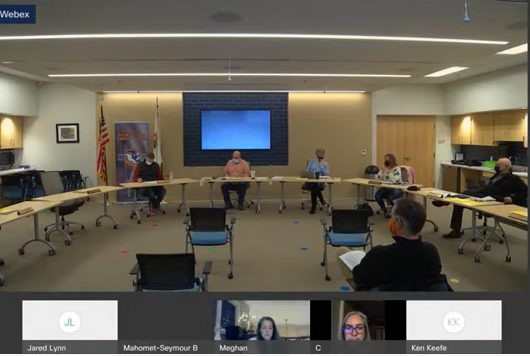M-S Board passes MOU, Union signals agreement made under pressure

By Dani Tietz
The Mahomet-Seymour School Board met twice during the week of Jan. 17
to discuss and ultimately pass a Memorandum of Understanding (MOU)
with the Mahomet-Seymour Education Association.
The board met during their regular meeting on Jan. 19 without board
member Jeremy Henrichs. The MOU failed during vote 3-3: Max McComb,
Merle Giles and Lori Larson voting for and Meghan Hennesy, Ken Keefe
and Colleen Schultz voting against the measure.
The next day, a special meeting was called for Jan. 22 in order to
take another vote with Henrichs present. After about a half-hour of
discussion, the board passed the MOU, with Henrichs tipping the
balance.
The MOU, which was first established on Aug. 17, expired Oct. 1, 2020
established the workday to be 8 a.m. to 3:30 p.m, Monday-Friday as
opposed to “one-half hour prior to and one-half hour after the
student’s academic day,” according to the 2018 negotiated contract.
The Mahomet-Seymour staff had been operating on the MOU without
another agreement since October.
Superintendent Lindsey Hall emailed staff on Jan. 10, stating that the
district was working with the MSEA on a new MOU. She wrote, in part:
“I am asking that teachers and paraprofessionals voluntarily commit to
these work hours from first semester (8:00-3:30 for MPE, JH, HS and
8:15-3:45 for LT) until a new MOU is finalized. I realize that the
vast vast majority of you are already doing this (and even working
longer!).”
Hennesy, Keefe and Schultz stated that they voted against the MOU for
different reasons.
Hennesy was not opposed to the working hours in the MOU, but stated
that she had heard concerns from teachers that the MOU came to the
board under pressure.
“People were feeling like they were backed into the corner and having
to say yes and they might have wanted to say no,” she said on the
19th. Hennesy asked that the board meet with and hear from the
teacher’s union prior to accepting the MOU to understand what they
went through.
Through a FOIA request, the Mahomet Daily obtained a response from
MSEA leadership to an email from Lori Larson, which asked if the union
had “concerns or questions” about the MOU.
MSEA Leadership responded that their concerns came from a Jan. 8
meeting with Superintendent Lindsey Hall in which they “heard” that if
they did not sign the new MOU, Hall would ask the board to consider
the following items:
“Administration/Board would consider taking away Monday’s as
asynchronous learning/remote planning days and turn them into student attendance/work days;
Administration would be asking the board to re-evaluate staff pay, based on the amount of hours being worked, if MSEA chose to follow the contract language for work hours (since these hours now differ from when the contract was originally negotiated);
The district would no longer be willing to be flexible with staff for
personal or family needs that may arise, as they have in the past.”
On the 22nd, Hennesy asked McComb, Giles, Henrichs and Larson if they
wanted to work to understand the concerns of the MSEA.
“I guess my question to each of you is, you don’t have any concerns
about the email that was sent by the union that appeared to suggest
that they were feeling threatened during the meeting where this
memorandum was put together?” Hennesy asked. “And you have no
inclination to dig into that before just signing this memorandum
though having never spoken to anyone with respect to those concerns?”
Henrichs replied, “no.”
Giles also did not.
“This is the practice we had all fall; I just don’t understand any
basis for this thread,” Giles said.
McComb said that he, too, did not have any concerns.
“We can still meet with the union if we want to do that, but we need
the work rules in place. The staff needs to know what the work rules
are.”
Hennesy said that the staff had been operating under the first MOU
since Oct. 1, but she did not understand the urgency to signing the
new MOU without taking the time to understand what the union heard and
felt during the negotiating process.
Hall said that because the schedule had moved from hybrid to four
full-person in-school days per week, a new MOU was necessary.
Giles said that a large organization with hundreds of employees needs
to have this agreement so that people know when they are supposed to
be working.
Because the MOU had expired, the negotiated contract hours would have
been in place until 2022.
Keefe, on the other hand, was concerned that the MOU would be an
agreement that would keep school at four days of in-person school
throughout the rest of the 2020-21 school year.
“It codifies that Mondays will remain asynchronous for the entire rest
of the school year. I am really unsure of why, given that Dr. Hall
just tonight, sent out information about vaccines rolling out to our
staff, and we’re seeing the numbers of COVID infections dropping in
our area,” he said. “I personally am hopeful that we will be back to
pretty much normalcy by about spring break.”
But Giles said that because the board meets twice a month, the
agreement could change as circumstances change.
“We have flexibility like we have every year since we began to make
rules as things change,” Giles said.
“Terms can be renegotiated,” Henrichs added.
Keefe was also concerned that the board of education was entering into
an agreement, one between the board and the MSEA, that the board did
not participate in producing.
“I think we all, as a board, need to get on the same page about what
it is we want to be negotiating. I don’t know where the position of
the district came from, because the board didn’t discuss or decide
what it is we wanted.”
But Henrichs said that the board of education hired Superintendent
Hall to do the negotiating work for the public body.
Schultz wanted to understand more about how the work hours, with the
teacher workday ending at 3:30, just minutes after students finish
receiving instruction.
“I have always been under the impression, as a parent and a board
member, that one of the reasons for teachers to come to school a half
an hour before and a half an hour after school is to provide support
to students who might need extra help,” Schultz said.
“I know many students, who, on a regular basis, do that. I know we
have absolutely fabulous teachers, and if we wanted to, I could spend
the meeting until tomorrow telling you stories about how great
teachers have been to help people; they help kids, it’s great.
“But this new contract says, at the high school in particular, that
nine minutes after school is over, the teachers are finished. And so,
this eliminates our ability to have students get help from their
teachers after school.”
Schultz said she was concerned about this practice after hearing from
Director of Instruction Nicole Rummel about the number of students who
had received D’s and F’s on their report card during the first
semester.
“So, it seems to me that adjusting our schedule to take away a
student’s opportunity to get help after school might not be their
interest, not having teachers work a full workday,” Schultz said.
She added that she knows many of the teachers will stay outside of
their required work hours to help students, but “then we’re putting
them in a position where it’s after the workday is over.”
It was brought up that teachers had morning hours to meet with
students, and that Mondays were also a time for students to get
additional help.
Schultz said that some students could not make it in the morning hours.
Hall said that she appreciated Schultz’s concern and that she was
willing to think about the students. She added that because of
COVID-19 restrictions, with only 50 students on a bus at a time, the
district had to reconfigure the start and end times of the school day
to accommodate for the transportation schedule.
“Our teachers are finding unique and creative ways to meet the needs
of our students and provide help when needed,” Hall said. “I couldn’t
agree more, Dr. Schultz, about how awesome our teachers are in wanting
to help students, to find new ways to make that happen.”




